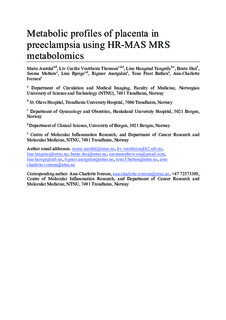| dc.contributor.author | Austdal, Marie | |
| dc.contributor.author | Thomsen, Liv Cecilie Vestrheim | |
| dc.contributor.author | Tangerås, Line Haugstad | |
| dc.contributor.author | Skei, Bente | |
| dc.contributor.author | Mathew, Seema | |
| dc.contributor.author | Bjørge, Line | |
| dc.contributor.author | Austgulen, Rigmor | |
| dc.contributor.author | Bathen, Tone Frost | |
| dc.contributor.author | Iversen, Ann-Charlotte | |
| dc.date.accessioned | 2017-09-25T11:10:00Z | |
| dc.date.available | 2017-09-25T11:10:00Z | |
| dc.date.created | 2015-09-28T23:46:09Z | |
| dc.date.issued | 2015 | |
| dc.identifier.citation | Placenta. 2015, 36 (12), 1455-1462. | nb_NO |
| dc.identifier.issn | 0143-4004 | |
| dc.identifier.uri | http://hdl.handle.net/11250/2456514 | |
| dc.description.abstract | Introduction
Preeclampsia is a heterogeneous gestational disease characterized by maternal hypertension and proteinuria, affecting 2–7% of pregnancies. The disorder is initiated by insufficient placental development, but studies characterizing the placental disease components are lacking.
Methods
Our aim was to phenotype the preeclamptic placenta using high-resolution magic angle spinning nuclear magnetic resonance spectroscopy (HR-MAS MRS). Placental samples collected after delivery from women with preeclampsia (n = 19) and normotensive pregnancies (n = 15) were analyzed for metabolic biomarkers including amino acids, osmolytes, and components of the energy and phospholipid metabolism. The metabolic biomarkers were correlated to clinical characteristics and inflammatory biomarkers in the maternal sera.
Results
Principal component analysis showed inherent differences in placental metabolic profiles between preeclamptic and normotensive pregnancies. Significant differences in metabolic profiles were found between placentas from severe and non-severe preeclampsia, but not between preeclamptic pregnancies with fetal growth restricted versus normal weight neonates. The placental metabolites correlated with the placental stress marker sFlt-1 and triglycerides in maternal serum, suggesting variation in placental stress signaling between different placental phenotypes.
Discussion
HR-MAS MRS is a sensitive method for defining the placental disease component of preeclampsia, identifying several altered metabolic pathways. Placental HR-MAS MRS analysis may improve insight into processes affected in the preeclamptic placenta, and represents a novel long-required tool for a sensitive placental phenotyping of this heterogeneous disease. | nb_NO |
| dc.language.iso | eng | nb_NO |
| dc.publisher | Elsevier | nb_NO |
| dc.rights | Attribution-NonCommercial-NoDerivatives 4.0 Internasjonal | * |
| dc.rights.uri | http://creativecommons.org/licenses/by-nc-nd/4.0/deed.no | * |
| dc.title | Metabolic profiles of placenta in preeclampsia using HR-MAS MRS metabolomics | nb_NO |
| dc.type | Journal article | nb_NO |
| dc.type | Peer reviewed | nb_NO |
| dc.description.version | acceptedVersion | nb_NO |
| dc.source.pagenumber | 1455-1462 | nb_NO |
| dc.source.volume | 36 | nb_NO |
| dc.source.journal | Placenta | nb_NO |
| dc.source.issue | 12 | nb_NO |
| dc.identifier.doi | 10.1016/j.placenta.2015.10.019 | |
| dc.identifier.cristin | 1276367 | |
| dc.relation.project | Norges forskningsråd: 205400 | nb_NO |
| dc.relation.project | Norges forskningsråd: 223255 | nb_NO |
| dc.description.localcode | Copyright © 2015 Elsevier Ltd. All rights reserved.This is the authors' accepted and refereed manuscript to the article. | nb_NO |
| cristin.unitcode | 194,65,25,0 | |
| cristin.unitcode | 194,65,15,30 | |
| cristin.unitcode | 194,65,15,0 | |
| cristin.unitname | Institutt for sirkulasjon og bildediagnostikk | |
| cristin.unitname | Centre of Molecular Inflammation Research (SFF-CEMIR) | |
| cristin.unitname | Institutt for kreftforskning og molekylær medisin | |
| cristin.ispublished | true | |
| cristin.fulltext | postprint | |
| cristin.qualitycode | 2 | |

